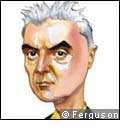
E.E.E.I. |
"PowerPoint Pathos"
”His contract says that ‘the artist speaks for only 35 minutes’,” an organiser warns two excited Canadians heading for their seats. Thirty-five minutes? Surely this can’t be enough. Not when the artist doing the speaking is David Byrne, front man of the groundbreaking rock band Talking Heads. Alas, it seems Byrne’s handlers have imposed exacting constraints on the evening: a time limit and the stipulation that the musician-cum-visual artist does not sign anything but Envisioning Emotional Epistemological Information, his most recent book. A young man gripping a stack of albums in the sixth row shrugs in disappointment. But it could have been worse: the free lecture is massively oversubscribed and outside in the cold people are holding signs saying “We need tickets”, as if waiting for the sort of rock concert that made the twitchy Byrne so famous in the 1980s. Inside, we are about to see the ageing icon perform something very different: a PowerPoint lecture about... PowerPoint. Byrne, a former art student, has been using the ubiquitous Microsoft presentation software to create art for several years now and produced a book and DVD of his work last year. But for many here this is the first chance they have had to see him show his material in person. He was drawn to PowerPoint because its inane, pronoun-free language is so often the butt of jokes. The lecture is titled “I ♥ PowerPoint”, and he has the slides to prove it. It kicks off at 6.30pm, unusual in New York both for the early hour and punctual start. Byrne, sporting a dark, sleek suit, mustard shirt and white spiked hair, begins as countless baffled professors and CFOs have before him: “Is this going to work?” he asks as he fiddles with his computer. It does, and, as a header-and-bullet-point display appears on the screen, Byrne playfully follows the format. “This is a PowerPoint presentation about PowerPoint presentations. I’m going to tell you how it works, who invented it, what it’s good for and what it’s not good for.” This should be interesting: one of the many awful things about PowerPoint slide shows is the way they so often compete with the speaker, mucking up oral punch lines with visual ones. At first, Byrne evades this pitfall. As he explains with mock self-pity that he didn’t grow up using PowerPoint, the screen flashes the heading: “Attitudes towards the poor”. The attempted joke draws too-hardy a laugh from the crowd - and a happy giggle from Byrne himself. Byrne has mined the internet for many of the slides he shows, including a PowerPoint treatment of the Gettysburg Address and another of Hamlet. We learn that the man most to blame for the incessant bullet points and one-line injunctions that have invaded corporate presentations the world over is Whitfield Diffie, a former peacenik cryptologist. Byrne’s father was an electronics engineer and talk of the craft behind the art brings out in the singer a surprisingly articulate speaker. PowerPoint, he says, “has an unfortunate identity, but it could almost have no identity. It could almost be, if not a blank slate, an empty net.” In the theory portion of the lecture, however, he starts to stumble. His brief history of the software feels superficial. His attempt to analyse the pernicious nature of PowerPoint’s AutoContent Wizard, which provides ready-made templates (”Motivating a Team”; “Have an Inspirational Close”), feels weak. And his attack on the schism the software creates between image and meaning seems arbitrary: surely this does not apply to PowerPoint alone? As the 35-minute mark approaches, Byrne aims for an about-face. He says he does see a sort of theatre in PowerPoint, and he admires the catch-all nature of the software: “You can throw any kind of programme at it [photos, audio files, video] and it will hold it. It will say, ‘OK, I’ll have some of that too.’” When he breaks for questions, one person asks him to create a few slides on the spot. He agrees but, irritatingly, the technology will not co-operate. As he gives up, a large man in a herringbone jacket asks what sounds at first as if it will be the sort of question that sums up an evening and allows everyone to leave feeling smarter for the hour spent indoors. Instead, he says he was disappointed that Byrne did not include music in his presentation. Byrne looks dismayed. “I didn’t want to come here and just talk about my own work. I wanted to talk about the larger implications. ”I guess you’re not seeing the thing,” he concedes in a low voice. “You’re not seeing me talk about the thing. I’m talking way around it.” With that confession, the screen blinks on and an image appears - the beginnings of the slide Byrne had promised to create before our very eyes. It is rather beautiful. In the centre of a blue gingham field sits a small photo of a baby, crying. “That’s as far as I got,” says Byrne. The audience applauds wildly and the laptop snaps shut.
|



 The crowd is still settling inside New York University’s spacious Kimmel Center auditorium for the annual Marshall McLuhan Lecture, when the first bit of bad news breaks.
The crowd is still settling inside New York University’s spacious Kimmel Center auditorium for the annual Marshall McLuhan Lecture, when the first bit of bad news breaks.